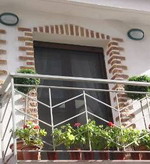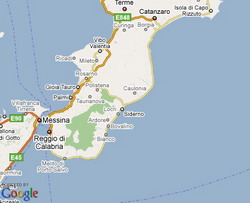Italy
Travel Guide
Calabria
Seaside Featured Hotels
Self-Catering
in Calabria
I
Love Italian Wine and Food - The Calabria Region
The
Calabrian Region of Italy
|
 Villetta
Mimma Vittoria (Ref: 1376), self-catering villa in Gioia Tauro, Italy Villetta
Mimma Vittoria (Ref: 1376), self-catering villa in Gioia Tauro, Italy 
All guests renting
Villetta Mimma Vittoria (named after the owner’s mom) will be greeted with
a welcome care package containing local Calabrian products of (virgin olive
oil - grown, harvested and cold pressed by the owner’s relatives in nearby
Seminara, fruits and vegetables (in season) grown and harvested by the
owner’s relatives in nearby Ponte Vecchio,.. Sleeps 6. |

View
map of the Calabria Coast, Italy
|
I
Love Italian Wine and Food - The Calabria Region by Levi Reiss
Calabria
Seaside Featured Hotels
/ Self-Catering
in Calabria
Calabria is the toe of the
Italian boot. It is located in the southwest corner of Italy, with 500
miles of coastline on the Ionian, Mediterranean, and Tyrrhenian Seas. Its
total population is about 2 million. The countryside is mountainous, and
prone to earthquakes. For centuries peasants worked very hard to eke out
a living from its poor soil. During the last century over a million people
left Calabria to seek a better life in Northern or Central Italy or overseas. |
 Historically,
the region’s first name was Italia, probably from the Italic tribes that
inhabited the area. Over time, Calabria has belonged to the Greeks, the
Romans, and the Byzantines. Others who lived in the area include Armenians,
Bulgarians, Catalans, Goths, Spaniards, Normans, and Bourbons. Talk about
multiculturalism. Historically,
the region’s first name was Italia, probably from the Italic tribes that
inhabited the area. Over time, Calabria has belonged to the Greeks, the
Romans, and the Byzantines. Others who lived in the area include Armenians,
Bulgarians, Catalans, Goths, Spaniards, Normans, and Bourbons. Talk about
multiculturalism.
While Calabria has been poor,
its agricultural production is important. For example, it is the source
of about 25% of Italian olive oil. Other agricultural products include
vegetables, especially eggplants, peppers, tomatoes, artichokes, asparagus,
and mushrooms. Its citrus fruits and figs are special. There is plenty
of wheat for pasta, country-style bread, focaccia, and pizza. The main
meat is pork, and some Calabrian salami is famous. Other meats include
lamb and goat. The seas yield anchovies, cod, sardines, swordfish, and
tuna. Cheeses include Caciocavallo Silano and Crotonese, reviewed below.
Christmas and Easter are accompanied by traditional desserts. You won’t
go hungry in Calabria.
| Perhaps you haven’t heard
of Calabria’s cities including Cosenza, Reggio di Calabria, and the regional
capital, Catanzaro. The largest of the three, Reggio di Calabria, has fewer
than 200 thousand people. But big cities are hardly a requirement for good
wine. Few would ever claim that Italy’s best wines come from Rome, or the
surrounding area. Hills and mountains, sunny days and cool nights, maritime
breezes, low rainfall, and poor soil are all factors that can lead to excellent
wines. Calabria definitely has winemaking potential.
Calabria devotes about sixty
thousand acres to grapevines, it ranks 13th among the 20 Italian regions.
Its total annual wine production is slightly less than twenty million gallons,
giving it a 15th place. About 91% of the wine production is red or rosé
(a bit of rosé), leaving 9% for white. |

Buy
at AllPosters.com
|
The region produces 12 DOC
wines. DOC stands for Denominazione di Origine Controllata, which may be
translated as Denomination of Controlled Origin, presumably a high-quality
wine. Only 2.4% of Calabria wine carries the DOC designation. The region
is home to almost three dozen major and secondary grape varieties, half
white and half red.
Widely grown international
white grape varieties include Chardonnay, Trebbiano, and Malvasia. The
best known, strictly Italian white variety is Greco Bianco, which makes
an excellent sweet wine that is very hard to find outside of the region.
In general, Calabrian white wines are difficult to find in North America.

Buy
at AllPosters.com
|
Widely grown international
red grape varieties include Cabernet Sauvignon and Merlot. The best known
strictly Italian white variety is Gaglioppo, whose flagship wine, Ciró
we review below. Keep your eyes open for wines made from the indigenous
Magliocco red grape.
Before reviewing the Calabria
wine and cheese that we were lucky enough to purchase at a local wine store
and a local Italian food store, here are a few suggestions of what to eat
with indigenous wines when touring this beautiful region. Start with Pitta
Chicculiata, Pizza with Tuna, Tomato, Anchovies, Black Olives, and Capers.
Then try La Carne ‘Ncantarata dei Fratelli Alia, Pork Loin in Honey-Chili
Glaze. For dessert, indulge yourself with Fichi al Cioccolato, Chocolate-Covered
Roasted Figs.
OUR WINE REVIEW POLICY
While
we have communicated with well over a thousand Italian wine producers and
merchants to help prepare these articles, our policy is clear. All wines
that we taste and review are purchased at the full retail price.
 Wine
Reviewed Librandi ‘Duce San Felice’ Ciró Reserva 2001 13.5% alcohol
about $15 Wine
Reviewed Librandi ‘Duce San Felice’ Ciró Reserva 2001 13.5% alcohol
about $15
|
Some claim that Ciró
is the oldest existing wine. It is said to come from a wine consumed by
victorious Calabrian athletes on their return from the Olympics well over
2500 years ago. This DOC wine grows in the low hills near the Ionian Sea
in eastern Calabria not far from the Sila Massif plateau. If you ask me,
the geographical characteristics worked out quite well for this wine.
Ciró is made from
the indigenous Gaglioppo red grape, which has a light-colored pulp and
very thick skin. In spite of the grape skins, this wine contains light
tannins. Personally I found the tannins excellent, they melted into the
food and I say this as someone who is not overly fond of tannins. I tried
this Ciró with barbecued boneless beef ribs marinated in a somewhat
spicy tomato sauce and loved the way the fruit flavors accompanied the
food. Sometime after the meal I reread the wine store’s review and agreed
with their quote “…This Librandi has tangy texture with complex, juicy
red fruit, and overall it’s very attractive. It’s just great for barbecued
meats…”
Crotonese is a pure sheep’s
milk cheese found in Calabria. It is made in 4 pound wheels with a very
light rind. Its color ranges from pale yellow to creamy yellow. Crotonese
is an excellent grating cheese. Another recommendation is to slice it thinly
and drizzle olive oil, especially Calabrian Crotonese olive oil, over it.
Its flavor is both salty and sweet, and is mildly sharp. I tried it for
lunch with a mixture of humus (ground chickpeas) and processed vegetables,
toast, and the Ciró Reserva. The wine and cheese flavors blended
well. Another recommended wine for Crotonese cheese is the classic Tuscan
Brunello di Montalcino at about three times the cost of this Ciró.
top
/ Calabria
Seaside Featured Hotels
/ Self-Catering
in Calabria
About the Author -
Levi Reiss has authored or co-authored ten books on computers and the Internet,
but to be honest, he would rather just drink fine Italian or other wine,
accompanied by the right foods. He teaches classes in computers at an Ontario
French-language community college. His wine website is www.theworldwidewine.com. |

